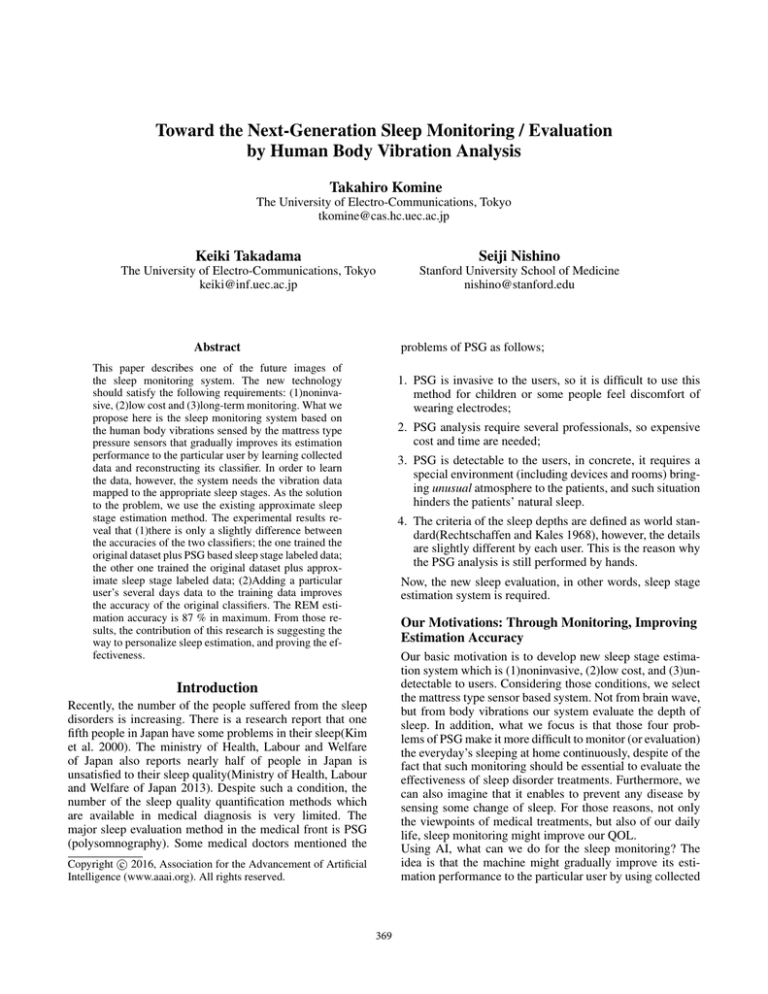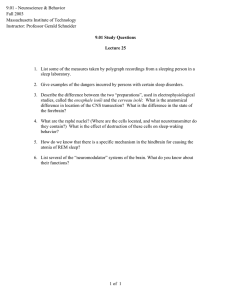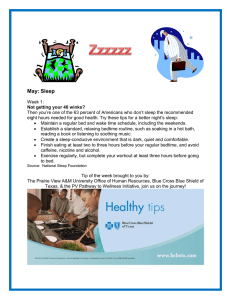
Toward the Next-Generation Sleep Monitoring / Evaluation
by Human Body Vibration Analysis
Takahiro Komine
The University of Electro-Communications, Tokyo
tkomine@cas.hc.uec.ac.jp
Keiki Takadama
Seiji Nishino
The University of Electro-Communications, Tokyo
keiki@inf.uec.ac.jp
Stanford University School of Medicine
nishino@stanford.edu
problems of PSG as follows;
Abstract
This paper describes one of the future images of
the sleep monitoring system. The new technology
should satisfy the following requirements: (1)noninvasive, (2)low cost and (3)long-term monitoring. What we
propose here is the sleep monitoring system based on
the human body vibrations sensed by the mattress type
pressure sensors that gradually improves its estimation
performance to the particular user by learning collected
data and reconstructing its classifier. In order to learn
the data, however, the system needs the vibration data
mapped to the appropriate sleep stages. As the solution
to the problem, we use the existing approximate sleep
stage estimation method. The experimental results reveal that (1)there is only a slightly difference between
the accuracies of the two classifiers; the one trained the
original dataset plus PSG based sleep stage labeled data;
the other one trained the original dataset plus approximate sleep stage labeled data; (2)Adding a particular
user’s several days data to the training data improves
the accuracy of the original classifiers. The REM estimation accuracy is 87 % in maximum. From those results, the contribution of this research is suggesting the
way to personalize sleep estimation, and proving the effectiveness.
1. PSG is invasive to the users, so it is difficult to use this
method for children or some people feel discomfort of
wearing electrodes;
2. PSG analysis require several professionals, so expensive
cost and time are needed;
3. PSG is detectable to the users, in concrete, it requires a
special environment (including devices and rooms) bringing unusual atmosphere to the patients, and such situation
hinders the patients’ natural sleep.
4. The criteria of the sleep depths are defined as world standard(Rechtschaffen and Kales 1968), however, the details
are slightly different by each user. This is the reason why
the PSG analysis is still performed by hands.
Now, the new sleep evaluation, in other words, sleep stage
estimation system is required.
Our Motivations: Through Monitoring, Improving
Estimation Accuracy
Our basic motivation is to develop new sleep stage estimation system which is (1)noninvasive, (2)low cost, and (3)undetectable to users. Considering those conditions, we select
the mattress type sensor based system. Not from brain wave,
but from body vibrations our system evaluate the depth of
sleep. In addition, what we focus is that those four problems of PSG make it more difficult to monitor (or evaluation)
the everyday’s sleeping at home continuously, despite of the
fact that such monitoring should be essential to evaluate the
effectiveness of sleep disorder treatments. Furthermore, we
can also imagine that it enables to prevent any disease by
sensing some change of sleep. For those reasons, not only
the viewpoints of medical treatments, but also of our daily
life, sleep monitoring might improve our QOL.
Using AI, what can we do for the sleep monitoring? The
idea is that the machine might gradually improve its estimation performance to the particular user by using collected
Introduction
Recently, the number of the people suffered from the sleep
disorders is increasing. There is a research report that one
fifth people in Japan have some problems in their sleep(Kim
et al. 2000). The ministry of Health, Labour and Welfare
of Japan also reports nearly half of people in Japan is
unsatisfied to their sleep quality(Ministry of Health, Labour
and Welfare of Japan 2013). Despite such a condition, the
number of the sleep quality quantification methods which
are available in medical diagnosis is very limited. The
major sleep evaluation method in the medical front is PSG
(polysomnography). Some medical doctors mentioned the
c 2016, Association for the Advancement of Artificial
Copyright Intelligence (www.aaai.org). All rights reserved.
369
CV every 5 minutes of respiration. During the CV
is over the threshold θ1 , such epochs are estimated to
stage NREM-1. During CV is under the threshold θ3 ,
such epochs are estimated to stage NREM-3, otherwise
NREM-2. Tomura mentions those thresholds should be
θ1 = CV ∗ × 0.6, and θ3 = CV ∗ × 0.2, where CV ∗
indicates the value of CV of whole respiration data.
REM stage estimation criteria: Calculating averages every 5 minutes of the macro HRV wave: W , then estimate
the REM sleep when the average is above the threshold
θREM , calculated as the following equation; θREM =
Ave(W ) + Std(W ) × 0.6.
WAKE stage estimation criteria: Calculating
every minute of Activity, then estimate the WAKE
stage when the average is above the threshold θAct , calculated as the following equation;
θAct = Ave(Activity) + Std(Activity) × 0.6.
Note that the macro HRV wave: W is the waves filtered from
HRV wave which extracted from body vibration waves. Tomura uses the filter which transmits the waves of 1.23×10−4
to 2.5[Hz]. Also here the Activity indicates the standard deviation of the sensor values during 1second. Ave(x) and
Std(x) indicate the average and the standard deviation of
an array x, respectively.
data. We aim at developing the user-adaptive personalized
sleep stage estimation system based on the human body vibrations. Once the system begins operating, it goes on collecting the characteristics of him/her. Here, the word “characteristics” means, for example, the average rhythm of respirations and of heart beat variability. In other words, the
system learns, and gradually be personalized to the user.
Awating Solution
The idea is very simple, however, it has a potential problem.
In this research, we suppose that the sleep stage estimation
system improves by supervised learning technique. To improve itself, the system needs training data; the sensed vibration mapped to the appropriate sleep stages. As the true
sleep stages are acquired by using PSG analysis only, the approximate sleep stage estimation is needed.
Then, the questions are; (1)How to estimate the approximate sleep stages? (2)How much the estimation accuracy
improves using such approximate sleep stages?
In this paper, we provide one of the solutions of the question(1), and reveal the experimental results for (2).
Related Works
Sleep Stage
The world standard sleep criteria is defined as Sleep
Stage(Rechtschaffen and Kales 1968), based on PSG; the
states of brain waves, eye movements and activities of chin
muscles. The criteria classifis human sleep conditions into 6
stages; WAKE, REM, NREM-1, 2, 3 and 4. In this work
we cannot use those brain consition data directly, because
the mattress sensor could get only the vibration waves from
our body (chest, strictly).
Indirectly, however, the body activities responce the brain
consitions. What we should do is to catch the well-known
features which appear as body activities during REM sleep
as follows;
• The variablity of heart and respiration rate are increasing
than those of NREM sleep.
• The antigravity muscles relax.
• Twitch movements appear.
Proposed Method
Selecting the Type of the Sensors
The mattress type pressure sensors are (1) noninvasive, (2)
low cost. Generally, such sensors are undetectable to users
when they are set under the mattress. This time, we use
the TANITA Sleep Scan; SL-511(Noh et al. 2009) (Fig.1),
which is one of the commercially available pressure sensor in Japan. The sensor outputs the sensing values 16 times
per second. Note that the sensor covers only the area of the
chest.
Mattress Sensor based Sleep Stage Estimation
Some researcher develop the mattress sensor based sleep
stage estimation methods. Watanabe et al. (Watanabe and
Watanabe 2001) focused on the macro change of heart rate
variability (HRV) which is acquired from the filtered viblation waves. In the papers they reports that their method successfully extract the macro change of HRV, and that is correration to the sleep stage transition. This method has, however, a potential problem. That can extract the macro change
(or wave ) of HRV, but there is not a clear criterion that relates the amplitude of the wave and the depth of sleep stages.
Tomura et al. are inspired from Watanabe’s works, and they
propose the new criteria for REM sleep and WAKE detection (Tomura et al. 2015) as follows;
NREM stages estimation criteria: Suppose the coefficient of variationCV (x) = Std(x)/Ave(x). Calculating
Figure 1: TANITA Sleep Scan SL-511.
(http:\\www.tanita.co.jp\product\g\ TSL511WF\)
Inputs, Internal Processing and Outputs
From the pressure sensor, the input information is vibrations
from the patient’s body only. The sensor values of 30 seconds are shown in Fig.2. Here, the vibration includes respirations, heart beats, body motions and noise. In summary,
the proposed method senses vibrations of the user through
the sensor, and outputs the 6 levels of the labels; sleep stages.
The estimation is designed based on frequency domain analysis by the short-time Fourier transform (STFT). In concrete, every second the system applies Fourier transform to
370
2N ( where N is a user-defined natural number) sensed values. We focus on the power spectrums calculated by such
process. Fig.3 shows the spectrogram of the sensor value
which received during all the night (30000sec 8.5hours).
Despite from the brief observation, we can recognize some
patterns of the spectrums, and would estimate the condition
of the users sleep.
In this work we treat the human body wave in the frequency
domains and treat the sleep stage estimation as a classification task that classify the power spectrums into the 6 categories appropriately. Note that the all power spectrum are
standardized such that the summation of the all frequency
components equals to 1. In addition, because of the small
scale power of the high frequency regions( ≥ 5.0Hz), we
focus on only the frequency band under 5.0Hz.
1. Generate N sets of bootstrapped samples S1 , S2 ,...,SN .
2. Using each Si , grow trees Ti . Note that randomly sampled
mtry variables are only used for branching. The growing is end when the terminal nodes appears or the depth
reaches the threshold set in advance.
3. To the input, the trees T1 , T2 ,...,TN vote for the most popular class.
For the details, please refer to a thesis (Breiman 2001). RF
could be used as multi-class (i.e. more than 3 classes) classifier. This time, however, we combine several two-class RF
classifier models as shown in Fig.4.
Figure 2: Sensor values of 30 sec.
Figure 4: The proposed classification proceeding for sleep
stage estimation. Each classifier is a random forest model.
Improving Classifier
Suppose that the system has the classifiers, explained in the
previous subsection, and the data set S0 , initially. S0 is the
training data set of the classifiers, and is consisted of some
human subjects’ data. Each row is a pair of the frequency
components and corresponding sleep stage which is estimated by PSG analysis. The system improves itself through
reconstructing the classifiers using the S0 which is added the
user’s data as a training data.
As the first section mentiones, the user’s data does not have
“true” sleep stage labels. Thereupon we use the Tomura’s
method as the approximate estimation and label the sleep
stages to the additional data.
Experimental Conditions
Figure 3: Spectrogram of the human subject’s one night.
Research Participants
The information of the participants is shown in table. No human subject has any sleep disorder and any unsatisfuction to
own sleep. Each slept three nights. Some of them slept consecutively and the others did in a same week. During their
sleep, the sensor was on the bed under the low repulsion
mattress. At the same time we acquired each PSG, and the
sleep stages were estimated by the medical technologists we
offered.
Classifier for Sleep Stage Estimation
As the previous subsection mentions, our proposed system treats the power spectrums which are consisted of
320 variables. To tackle such large scale data sets, a machine learning method must be implemented as the classifier of the system. Here we select a random forest classifier model(Breiman 2001) because of its (1) readability, (2)
robustness to noise, and (3) robustness to class imbalance.
Random forest (RF) is a method which combines some decision trees that generated by randomly selected features and
samples. RF proceeding is as follows;
Construction of Initial Data Set and Classifiers
Initial data set S0 is constructed by the other nine human
subjects. Eight of them are in their 20s and the other is in
371
40s. They are all male, and no sleep disorder they have. Using this S0 , initial classifiers are constructed. The parameters
of each classifier (i.e. random forest) are; ntrees = 300,
mtry = 24.
When calculating accuracies, PSG’s WAKE estimated
epochs are excluded.
Results and Discussions
The reults are summarized in Fig.6. The left half columns
of the figure indicates the accuracies to all sleep stages
of each test data, the right half indicates that accuracies
to REM sleep. Let us look at the first row as an example.
The test data is subject A’s first night. The results of Case
1 is accuracy of the classifiers which learned the original
dataset S0 . Case 2 (a) is that of accuracy which learned
S0 plus subject A’s one data. There are two data of A;
day 2 and day 3, except of the test data. So, these results
shown here is the average of the two ways. And the same
things can be mentioned for the other results. The difference
between (a) and (b) is the sleep stage labels of the additional
data. In case (a), the labels are the results of PSG, that is,
“true” sleep stages. On the other hand, in case (b), the sleep
stages are labeled by the Tomura’s “approximately true”
estimation. In Case 3, the number of additional data is two.
The difference between (a) and (b) is the same thing of case
2.
Experiments
In the following experiments, we observe the classifiers be
personalized. As explained in the previous section, we have
three nights data sets for each human subject. Therefore,
it is possible to simulate the situation as follows — Our
proposed system monitored two nights of one person, and
learned him/her. Now we evaluate the estimation accuracy
of the system to the 3ed night.
We experiment the following five cases of each human
subject’s three-night data sets;
• Case 1: Test the classifiers which are trained by original
data set S0 .
• Case 2(a): Test the classifiers which are trained by modified S0 which is added one day data. The sleep stages of
the additional data are results of PSG, that is, the labels
are “true”.
• Case 2(b): Test the classifiers which are trained by modified S0 which is added one day data. The sleep stages
of the additional data are estimated by Tomura’s method,
that is, the labels are“approximately true”.
Accuracy Comparing
Focus on the average in the bottom row, the accuracies of the
Case 2 and 3 are above that of case 1. Furthermore, according to the Wilcoxon signal rank test(Wilcoxon 1945), the
differences between the mean of Case1 and of Case2, and
of Case1 and Case 3 are ststistically significant (p<0.01).
Those results indicate that the accuracy of the personalized
classifiers would better performed than the original classifiers. Next we focus on the Case 3(a) and (b). The difference
between those two are not statistically significant. This result reveals that there are only slightly difference between
the classifiers which learned “true” sleep stages estimated
data and those of “approximately true” one. In other words,
Tomura’s estimation method is available as supporting the
classifier improvement, as in this case.
One pair of the estimated sleep stages in Case1 and 3(b)
are shown in Fig.5. Comparing those two firures, we can see
the wrong estimated epochs to REM sleep and NREM-2 are
decreased after the two data added. Also focus on the red
dots, it can be said that the accuracy depends on REM accuracy and NREM-2 accuracy. Our classifiers mostly failed to
detect NREM-1 and NREM-3. The mechanism of the classifiers shown in Fig4 should be reconsidered.
• Case 3(a): Test the classifiers which are trained by modified S0 which is added two days data. The sleep stages
of the additional data are results of PSG, that is, the labels
are “true”.
• Case 3(b): Test the classifiers which are trained by modified S0 which is added two days data. The sleep stages
of the additional data are estimated by Tomura’s method,
that is, the labels are“approximately true”.
Considering the randomness of random forests, each case is
ran three times. The results we discuss are the average.
Evaluation Criteria
As evaluation criteria, we focus on accuracy (Metz 1978).
The measurement is defined as a ratio of the numbers of
epochs which the classifier answered correctly to the whole.
Accuracy to all sleep stages is mainly used to evaluation.
Also we use Accuracy to REM sleep supplementally.
Conclusion and Future Works
Table 1: The information of the human subjects.
Subject Age Sex
A
20
M
B
40
F
C
60
F
D
40
M
E
50
F
F
30
F
G
60
M
The aim of our research is developing the sleep stage estimation system based on the human body vibrations sensed
by the commercially available mattress type in bed pressure
sensors, toward the next-generation sleep monitoring technique which would supplant the current standard method,
PSG. In this paper we focus mainly on improving and personalization of the system through everyday’s sleep monitoring. Technically, the system adds the new sleep data by
day, and modifies its classifier using that data as training
372
[2] The result of Case 3(b).
[1] The result of Case 1.
Figure 5: The estimated sleep stages of subject A’s day 2. In those figures, the PSG sleep stages are indicated as gray lines.
The red and blue dots indicates correct and wrong estimated epochs, respectively. Note that the epochs which PSG estimated
as WAKE are excluded.
Figure 6: The results summary of case1,2 and 3.
R. 2000. An epidemiological study of insomnia among the
Japanese general population. Sleep 23(1):41?47.
data sets. Although the approximate sleep stage estimation is
needed for the system improving, we solve this problem using Tomura’s estimation method. Experimental results indicates that the added data with Tomura’s estimation has only
a slightly difference to the data with true sleep stage. That is,
effective as the improving support method. For those results
and arguments, we conclude that this research provides one
of the solutions for the personalized sleep stage estimation.
In the next stage, (1)we have to do long-term experiments for
researching the effectiveness of personalization; (2)the classification proceedings should be reconsidered; (3)we need to
discover a criteria of constructing the initial data set S0 .
Metz, C. E. 1978. Basic principles of roc analysis. In Seminars in nuclear medicine, volume 8, 283–298. Elsevier.
Ministry of Health, Labour and Welfare of Japan. 2013. National health and nutrition survey.
Noh, T.; Serizawa, Y.; Kimura, T.; Yamazaki, K.; Hayasaka,
Y.; Itoh, T.; Izumi, S.; and Sakai, T. 2009. The assessment of
sleep stage utilizing body pressure fluctuation measured by
water mat sensors. Journal of Advanced Science 21(1/2):27–
30.
Rechtschaffen, A., and Kales, A. 1968. A manual of standardized terminology, techniques and scoring system for
sleep stages of human subjects. Washington DC.
References
Breiman, L. 2001. Random forests. Machine Learning
45(1):5–32.
Tomura, S.; Harada, T.; Sato, H.; Takadama, K.; and Aoki,
M. 2015. Estimating surrounding symptom level of dementia patient by sleep stage. In Medical Information and Com-
Kim, K.; Uchiyama, M.; Okawa, M.; Liu, X.; and Ogihara,
373
munication Technology (ISMICT), 2015 9th International
Symposium on, 190–194.
Watanabe, T., and Watanabe, K. 2001. Estimation of the
sleep stages by the non-restrictive air mattress sensor. Transactions of the Society of Instrument and Control Engineers
37(9):821–828.
Wilcoxon, F. 1945. Individual comparisons by ranking
methods. Biometrics bulletin 80–83.
Acknowledgments
The research reported here was supported in part by
EMOOR Corporation and CAMPUS CREATE Corporation.
374





